
The Complete Guide to Choosing Urns for Cremation
Why Choosing the Right Cremation Urn Matters
Urns for cremation serve as the final resting place for your loved one's ashes and provide families with a meaningful way to honor their memory. With cremation chosen in more than 50% of funerals in the United States, selecting the right urn has become an increasingly important decision for families and funeral directors alike.
Quick Guide to Cremation Urns:
- Adult urns: Hold ashes from one person (typically 200+ cubic inches)
- Companion urns: Designed for two people's ashes
- Keepsake urns: Small urns for sharing portions of ashes among family
- Materials: Metal, ceramic, wood, marble, glass, or biodegradable options
- Sizing rule: 1 cubic inch per pound of body weight
- Uses: Home display, burial, scattering, or columbarium placement
The process of choosing an urn can feel overwhelming during an already difficult time. Families must consider size, material, intended use, personalization options, and budget - all while working through their grief. As one family member shared in our research, "Finding the right cremation urn can help you work through your loss by honoring a loved one's life."
Whether you're a funeral director helping families steer these choices or planning ahead for yourself, understanding the full range of options available makes this important decision easier and more meaningful.
I'm Mortuary Cooler, and I've spent years helping funeral homes across the country find reliable, high-quality equipment including urns for cremation that serve families with dignity and respect. My experience working directly with funeral directors has shown me how the right urn selection can provide comfort and closure during life's most difficult moments.
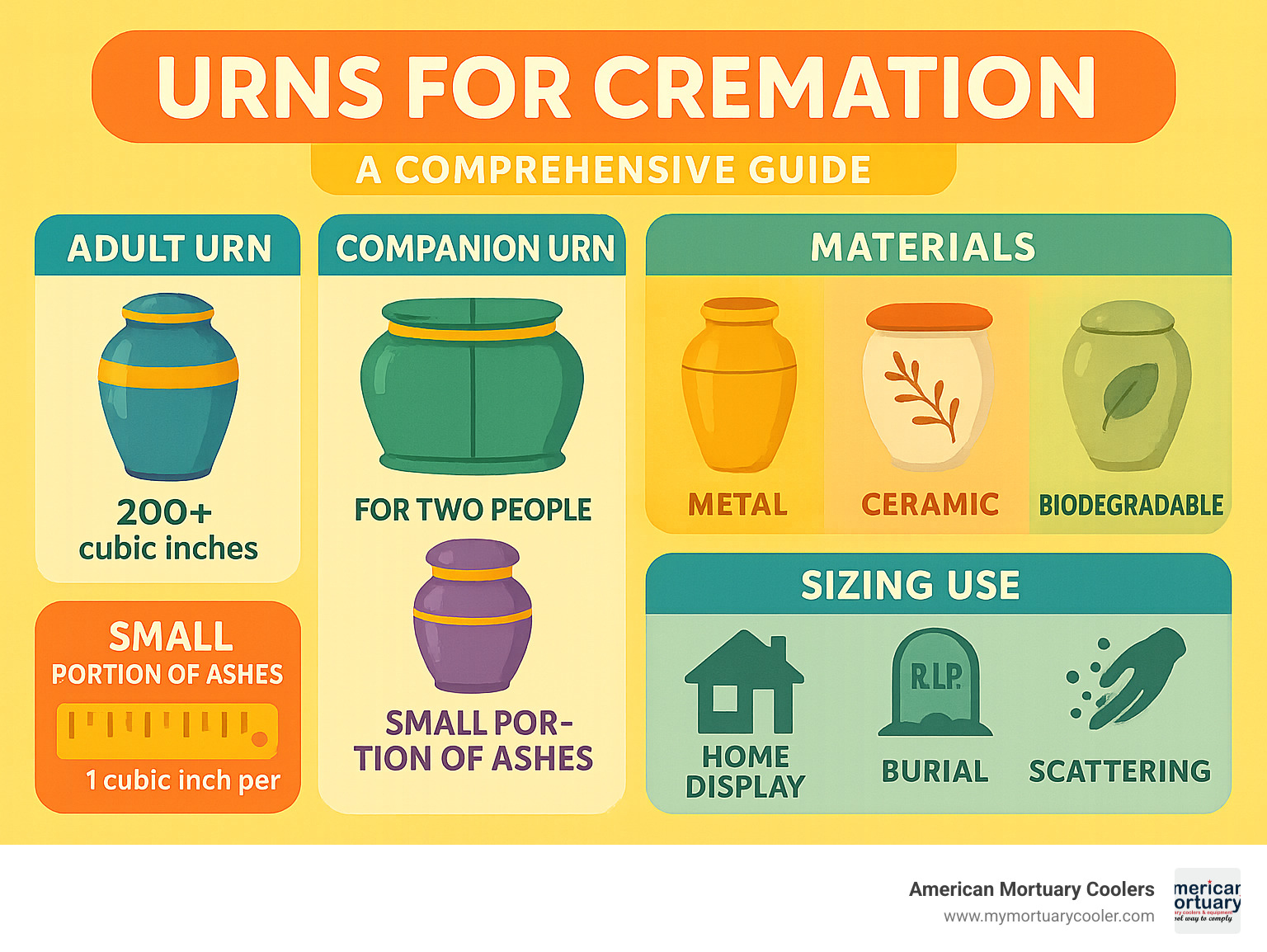
Relevant articles related to urns for cremation:
Understanding Cremation Urns: Purpose, Types & Sizes
When families choose cremation, they face an important decision about how to honor their loved one's memory. Urns for cremation are more than just containers - they're meaningful vessels that provide a lasting tribute while serving the practical purpose of safely holding cremated remains.
A cremation urn is essentially a decorative container, usually vase-shaped with a secure lid, designed specifically to hold ashes. These vessels bridge the gap between function and remembrance, offering families a tangible way to keep their loved one's memory close.
Adult urns represent the most common choice for families. These containers are designed to hold the complete ashes of one person and typically require a capacity of 200 cubic inches or more. The beauty of adult urns lies in their versatility - they work regardless of the person's original body size, making them the go-to standard for individual memorialization.
Companion urns offer something special for couples who want to remain together even after death. These larger containers are thoughtfully designed to hold two people's ashes, often featuring divided compartments or simply providing enough space to accommodate both sets of remains.
For families who want to share their loved one's memory, keepsake urns provide the perfect solution. These smaller containers hold just a portion of ashes, allowing multiple family members to keep a remembrance at home. It's become increasingly common for families to divide ashes this way - perhaps keeping some in keepsake urns while scattering or burying the rest elsewhere.
Pet urns deserve special mention because our animal companions hold such important places in our hearts. These containers come in various sizes to accommodate different pets, from small birds to large dogs, ensuring every beloved companion can be properly honored.
Understanding urn capacity doesn't have to be complicated. The general rule is simple: one cubic inch per pound of body weight. So if your loved one weighed 180 pounds, you'd need an urn with at least 180 cubic inches of capacity. The actual ashes typically weigh only about 3.5% of the original body weight. That means a 200-pound person's ashes will weigh between 5 and 10 pounds.
| Urn Type | Capacity | Best For |
|---|---|---|
| Adult | 200+ cubic inches | Individual adult remains |
| Companion | 400+ cubic inches | Two people's remains |
| Keepsake | 3-25 cubic inches | Portion of ashes for sharing |
| Pet | 5-200+ cubic inches | Based on pet's weight |
| Infant | 25-100 cubic inches | Children and infants |
Urns for Cremation by Intended Use
The way you plan to use an urn greatly influences which type you should choose. Display urns are designed with home placement in mind, prioritizing beauty and style that complements your living space. These containers often showcase materials like polished metal, glass, ceramic, or wood that blend seamlessly with home decor.
Burial urns face different challenges entirely. These containers must withstand underground conditions, moisture, and soil pressure over many years. That's why they're typically crafted from durable materials like cultured marble, genuine stone, or heavy-duty resin. Most cemeteries also require burial urns to be placed inside protective vaults for additional security.
When families choose to scatter ashes, scattering urns make the process more manageable and dignified. These specially designed containers often feature easy-opening mechanisms or are made from biodegradable materials that naturally dissolve during water ceremonies.
Niche urns must fit within the specific dimensions of columbarium compartments. Each facility sets its own size requirements, so it's crucial to verify these measurements before making your selection.
For outdoor memorial spaces, garden urns are built to weather the elements. Materials like bronze, granite, or stainless steel ensure these containers maintain their dignity and appearance through seasons of sun, rain, and temperature changes.
More info about urns vs. vaults
Sizing Guidelines for Urns for Cremation
Most urns for cremation follow the 200 cubic inch standard for adults, but some individuals require extra-large urns with capacities reaching 250 to 300 cubic inches or more. It's always better to choose an urn that's slightly larger than your calculations suggest.
Families often ask about dividing ashes among multiple containers. Keepsake urns typically hold between 3 and 25 cubic inches each, perfect for sharing among siblings, children, or close friends. This approach allows everyone to keep a personal remembrance while maintaining a primary urn for the majority of ashes.
Modern funeral homes increasingly use specialized calculators that consider factors beyond simple body weight, including BMI and bone density measurements. These tools provide more precise sizing recommendations, helping families choose the most appropriate container.
When in doubt, choosing a slightly larger urn protects against any miscalculations and accounts for variations in handcrafted dimensions. This small buffer provides peace of mind during an already emotional time.
Best Materials & Designs for Urns for Cremation
Choosing the right material shapes both the appearance and longevity of an urn. Below is a streamlined guide to help you match material to purpose without feeling overwhelmed.
Metal urns d especially brass and stainless steel d offer classic beauty and outstanding durability, making them suitable for indoor shelves or outdoor memorial gardens.
Ceramic urns top the popularity charts because they balance strength with limitless glazing and color options that accept detailed personalization.
Marble urns convey timeless dignity. Cultured marble delivers the stone look at a friendlier price, while genuine marble provides best natural elegance.
Wood urns in oak, mahogany, or pine create a warm, furnituredlike presence in the home and engrave cleanly for names, dates, or artwork.
Glass urns appeal to families who prefer sleek, contemporary décor; a quick gentle cleaning keeps them pristine.
Environmentally minded families often select biodegradable urns crafted from recycled paper, salt, or plant fibers. These vessels naturally break down in water or soil, leaving no longdterm footprint.
For exterior placement, granite, bronze, and stainless steel resist UV light, temperature swings, and moisture for generations.
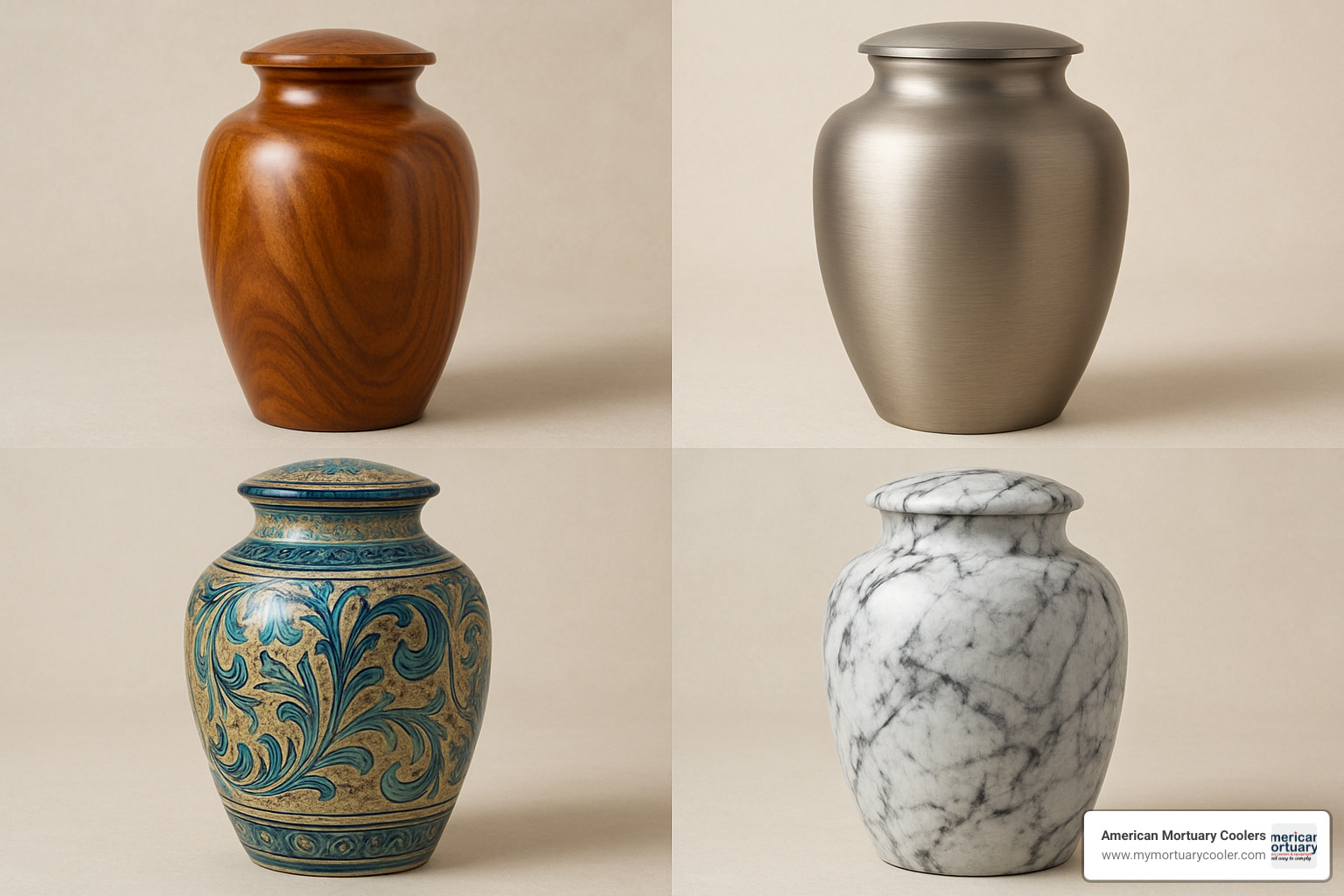
Current design trends celebrate individuality: nature motifs, faith symbols, military emblems, and handcrafted artisan work that mirrors hobbies or cultural heritage.
Scientific research on eco-friendly funerals
Home Display vs. Burial & Outdoor Placement
- Home display: Choose lowdmaintenance materials like metal, glass, ceramic, cloisonné, or wood.
- Burial: Prioritize moisture resistance with cultured or genuine marble, stone, or heavydduty resin and consider a protective urn vault.
- Outdoor placement: Opt for weatherdproof bronze, granite, or stainless steel for decades of resilience.
Practical Considerations: Filling, Sealing, Displaying & Legalities
When it comes to the practical side of urns for cremation, most families find the process less complicated than they initially feared. Understanding what to expect can help ease concerns during an already emotional time.
Filling the urn is typically handled by your funeral home staff, who have experience making this process as dignified as possible. The cremated remains are first placed in a plastic bag liner, which serves as a protective barrier inside the urn. This approach keeps everything clean and makes future handling easier if needed.
The funeral director will carefully transfer the bagged ashes into your chosen urn, ensuring everything fits properly and the urn closes securely.
Sealing methods depend on your urn's design and material. Many metal urns feature threaded lids that screw on tightly - just remember they typically turn left to open and right to close. Other urns, especially those made from ceramic, marble, or glass, may use adhesive sealants for a permanent closure.
While sealing isn't always legally required, it's highly recommended for security and peace of mind. A properly sealed urn prevents accidental opening during transport or handling.
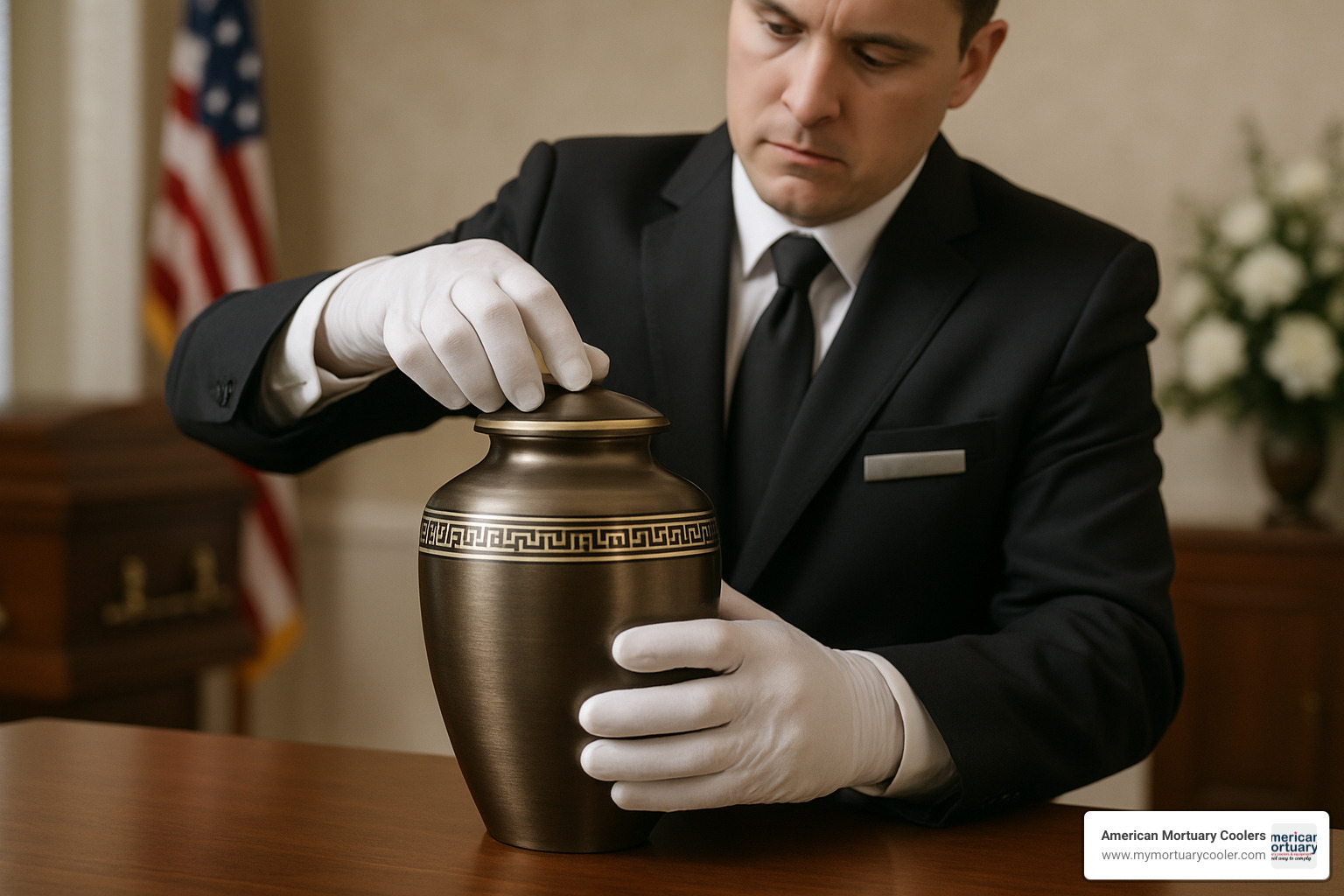
Shipping and delivery times have improved significantly in recent years. Many suppliers now offer free ground shipping on orders over $100, with typical delivery times of 3-7 business days. If you need your urn faster, expedited options are usually available, including 2-day shipping for around $30 and next-day delivery for approximately $50.
TSA rules allow you to travel with cremated remains, but there are important guidelines to follow. The urn must be made from materials that can be X-rayed - wooden, ceramic, and plastic urns typically pass through security without issues. Metal urns may require additional screening or could be prohibited, so check with your airline before traveling.
Cemetery requirements vary widely by location and facility type. Some cemeteries require all urns to be placed in protective burial vaults, while others allow direct burial. Columbarium facilities often have strict size restrictions for their columbarium niches, so always verify dimensions before purchasing.
Quality suppliers conduct thorough checks before shipping and often provide satisfaction guarantees. This attention to quality matters when you're making such an important purchase.
Step-by-Step: How to Fill & Seal an Urn
While most families prefer having their funeral home assist with filling and sealing, some choose to handle this process themselves. Here's what you need to know for a DIY approach.
Preparation is key. Gather protective gloves, a wide-mouth funnel if needed, and materials for clean-up. Choose a quiet, private space away from air currents that might disturb the ashes. Having everything ready beforehand makes the process smoother and more respectful.
The transfer process is usually straightforward since most funeral homes provide ashes in a sealed plastic bag. This bag can go directly into the urn without handling loose ashes. If you do need to transfer loose ashes, work slowly and deliberately to maintain dignity throughout the process.
Sealing the urn properly ensures security and peace of mind. For threaded lids, turn clockwise until snug but don't over-tighten. For adhesive seals, follow the manufacturer's instructions carefully and allow proper curing time before moving the urn.
Final cleaning removes any fingerprints or residue from the urn's exterior. Use appropriate cleaners for your urn's material - gentle household cleaners work well for most finishes.
Taking your time with each step helps ensure everything is done with the care and respect your loved one deserves.
More info about adult urn steps
Personalization, Eco-Friendly Options & Cost Guide
Making urns for cremation truly personal helps transform what could feel like a difficult purchase into a meaningful tribute. Today's personalization options let you create something that genuinely reflects who your loved one was - their interests, their faith, or simply the love your family shared.
Engraving brings memories to life in ways that feel both timeless and deeply personal. Laser etching can capture incredible detail, whether you're adding a favorite photo, a meaningful symbol, or simply their name and dates. Traditional engraving offers that classic, neat look that many families prefer. Photo printing using UV technology has become surprisingly popular - imagine seeing their smile or a favorite family picture right there on the urn.
The symbols and custom artwork options seem endless these days. Religious symbols, military emblems, hobby-related designs, or even recreations of their favorite flowers can all be incorporated. One family I worked with had their father's vintage car engraved on his urn - it made everyone smile through their tears because it was so perfectly him.
Going green with memorial choices has become much more than a trend - it's a way many families honor loved ones who cared about the environment. Biodegradable water urns offer something beautiful for families choosing water burial. These urns float gently for a few minutes, giving everyone time for final words, then gradually dissolve and release the ashes without harming marine life.
Tree urns create something amazing - a living memorial that grows stronger each year. Your loved one's ashes nourish the soil while a tree takes root and flourishes. It's a powerful way to think about life continuing in a new form.
Scattering tubes made from recycled materials solve a practical problem many families don't expect. Traditional scattering can be messy and even embarrassing when wind shifts unexpectedly. These biodegradable tubes make the process more dignified and controlled, which means more focus on the meaning of the moment.
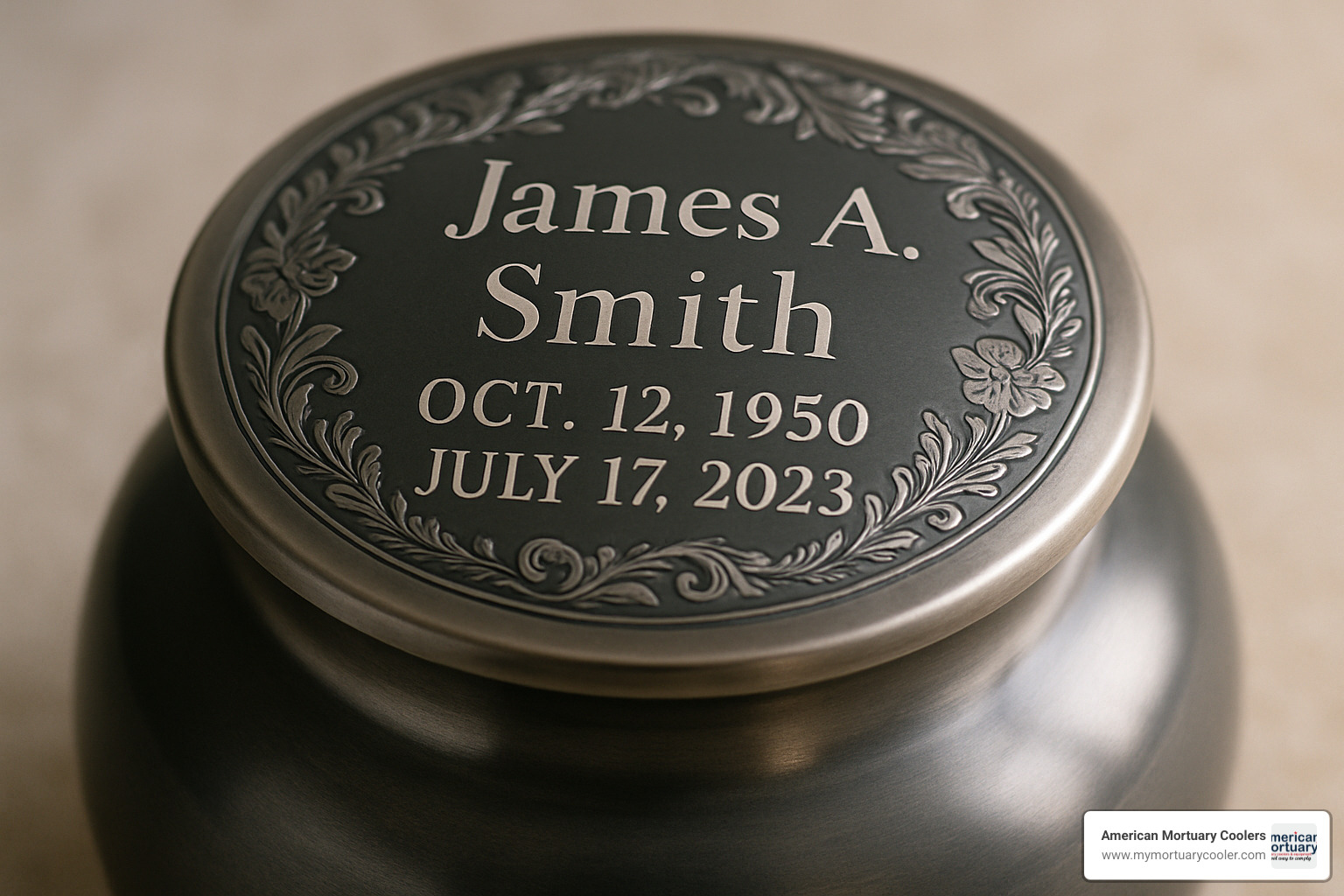
Understanding urn costs helps you make decisions that fit your budget while still honoring your loved one appropriately. The price range is wider than most people expect - from around $50 for simple but dignified options up to $600 or more for premium handcrafted pieces.
Material quality makes the biggest difference in pricing. A basic ceramic urn might cost $75-150, while a hand-forged bronze urn could run $400-600. The craftsmanship level matters too - mass-produced urns cost less than artisan-made pieces, but both can be beautiful and appropriate.
Size affects price more than you might think. Adult urns cost more than keepsake sizes, and companion urns for two people typically cost 50-75% more than single adult urns. Personalization adds to the cost, but usually not as much as families fear - basic engraving might add $25-75, while complex photo printing could add $100-200.
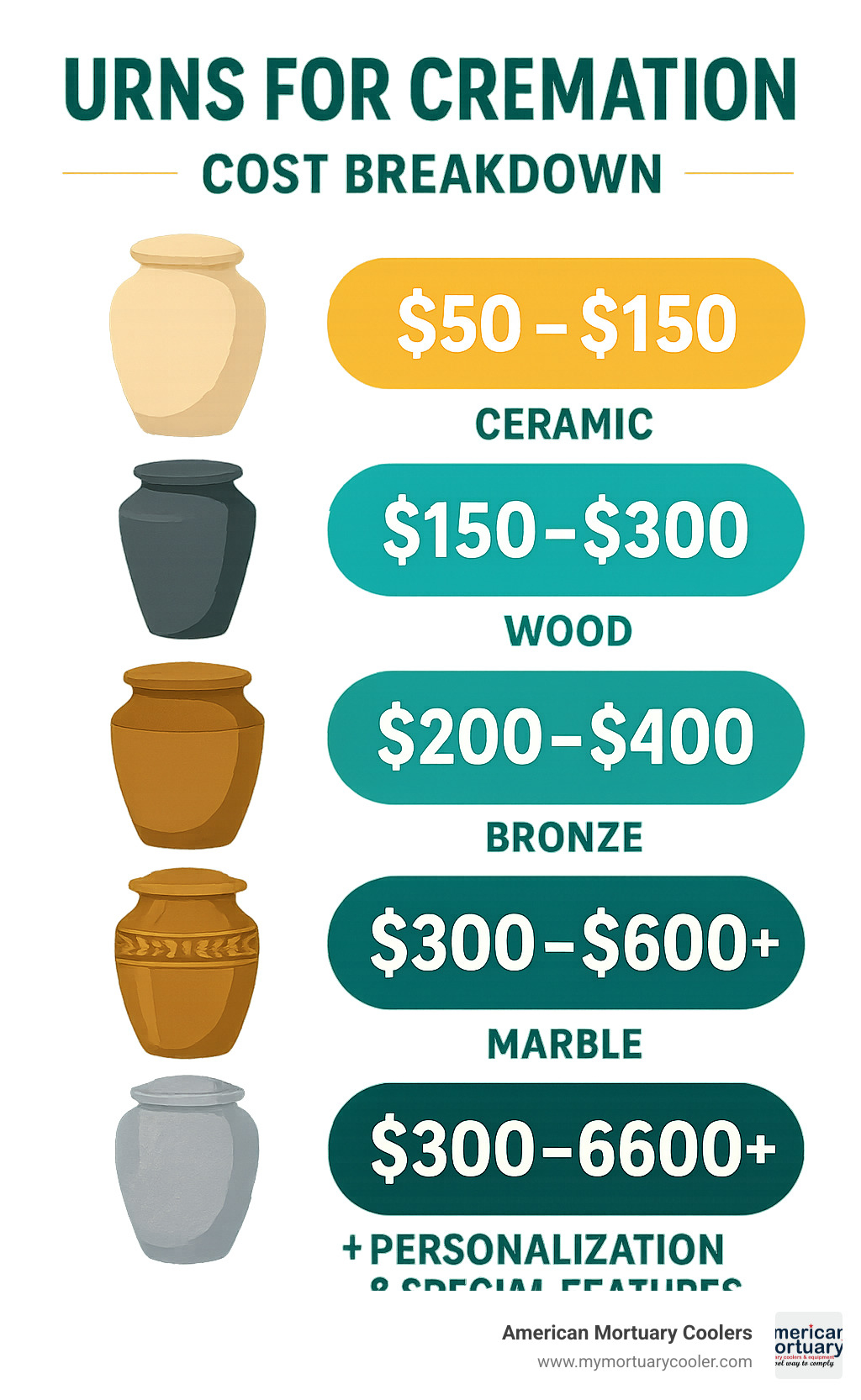
Brand reputation and guarantees can justify higher costs when you want peace of mind. Reputable manufacturers often provide satisfaction guarantees and quality assurance that protect your investment.
Dividing Ashes & Keepsake Alternatives
Sharing cremated remains among family members has become incredibly common, and for good reason. It allows everyone who loved the person to keep them close while still having a central memorial location for the family to visit together.
Keepsake urns work beautifully for this purpose, holding just a small portion of ashes - typically 3-25 cubic inches. Many families keep the majority of ashes in a standard adult urn for burial or display, then fill several keepsake urns for siblings, children, or close friends. It's a way of making sure no one feels left out of the memorial process.
Jewelry pendants offer something truly personal - a way to literally carry your loved one with you. These pieces have tiny compartments that hold just a pinch of ashes, sealed securely inside. They're surprisingly popular with adult children who want to keep their parent close during important life events.
Miniature urns provide a traditional approach to sharing ashes while maintaining that classic urn appearance. These smaller versions can sit on bedroom dressers, office desks, or anywhere someone wants a private place to remember. They're particularly meaningful for grandchildren who might not be ready for jewelry but want their own special memorial.
Family distribution often works best when one person takes the lead on coordination. They can work with the funeral home to divide the ashes appropriately, ensuring everyone gets what they want while maintaining dignity throughout the process.
Frequently Asked Questions about Urns for Cremation
What size urn do I need for human ashes?
The most common question families ask is about sizing, and the answer is simpler than you might think. The standard rule is 1 cubic inch per pound of body weight. So if your loved one weighed 150 pounds, you'll need approximately 150 cubic inches of urn capacity.
However, I always recommend choosing an urn with slightly more space than your calculation suggests. Handcrafted urns can vary in their actual capacity, and it's better to have a little extra room than to find the urn is too small. Most urns for cremation designed for adults range from 200-250 cubic inches, which comfortably accommodates this sizing guideline for most people.
That cremated remains typically weigh about 3.5% of the original body weight. This means a 200-pound person's ashes will weigh approximately 7 pounds, but they still need that full 200 cubic inches of space due to the volume the ashes occupy.
Do cremation urns need to be sealed, and how?
Sealing your urn is recommended for security and dignity, though it's not always legally required. The peace of mind that comes with proper sealing is worth the extra step, especially if the urn will be displayed in your home or transported.
Metal urns typically feature threaded lids that screw closed securely. These lids turn clockwise to tighten, creating a snug fit that prevents accidental opening. Ceramic, marble, or glass urns often require special adhesives for permanent sealing, which creates a more permanent closure.
The sealing method you choose depends on your plans for the urn. If you're using a temporary container for scattering ceremonies, permanent sealing isn't necessary. But if you're selecting urns for cremation for long-term display or burial, proper sealing protects both the contents and your family's peace of mind.
Can I divide ashes among multiple urns or keepsakes?
Absolutely, and this practice has become increasingly meaningful for many families. Dividing ashes allows multiple family members to keep a personal connection with their loved one, especially when family is spread across different locations.
Keepsake urns holding 3-25 cubic inches are perfect for sharing smaller portions of ashes. Many families choose beautiful jewelry pendants or miniature urns that can be displayed on mantels or shelves. This approach lets you honor your loved one in multiple ways - perhaps keeping the majority of ashes in a standard adult urn while sharing smaller portions in keepsake containers.
The beauty of this approach is its flexibility. You might keep one large urn as the primary memorial while giving each family member a small keepsake urn or piece of memorial jewelry. There's no right or wrong way to divide ashes - it's about what brings comfort and connection to your family during this difficult time.
Conclusion
Selecting the perfect urns for cremation is one of the most meaningful decisions you'll make during the grieving process. It's about more than just finding a container - you're choosing a lasting tribute that will honor your loved one's memory and provide comfort to your family for years to come.
Throughout this journey, there's no single "right" choice. The wooden urn that perfectly matches your living room decor is just as meaningful as the granite memorial that will weather decades in a garden setting. What matters most is that your choice feels authentic to your loved one's personality and brings peace to your heart.
Your legacy and honor decisions don't have to be made alone. Funeral directors understand the weight of these choices and can offer invaluable guidance based on their experience helping countless families. They've seen how the right urn can provide a sense of closure and comfort during life's most difficult moments.
The informed choices you make today - whether it's selecting a companion urn for devoted spouses, choosing keepsake urns to share among family members, or picking biodegradable options for environmental consciousness - will serve as a foundation for healing and remembrance.
We hope this guide has provided the caring support and practical information you need to make this important decision with confidence. Memorializing your loved one is a personal journey, and the perfect urn is simply the one that feels right for your family.
At American Mortuary Coolers, we're honored to support funeral professionals who guide families through these meaningful choices every day. Their dedication to serving families with dignity and compassion makes all the difference during life's most challenging moments.
Your loved one's memory deserves to be honored in a way that brings you comfort and peace. Trust your instincts, lean on the support of caring professionals, and know that the choice you make will be a beautiful tribute to a life well-lived.



